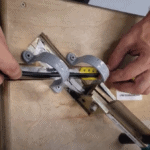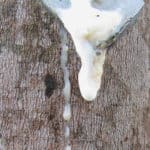Spliced and vulcanized o-rings are made from extruded cord stock that has been cut and bonded together, as opposed to molded o-rings; those that have been compression or injection molded as one piece. Vulcanized o-rings are an excellent choice for static sealing applications when molded o-rings cannot be used due to large or non-standard dimensions, when only a few pieces are needed, or when you need an o-ring right away and cannot wait the standard lead time for molded production. Vulcanized o-rings can be made from a range of elastomers and in virtually any size.
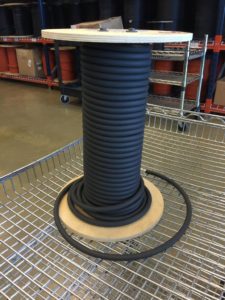 To make a vulcanized o-ring, continuous length cord is cut to length and then joined together. A bonding agent is applied to the ends which are then joined together in a mold at a high temperature for a specified period of time. This process forms the molecular bond necessary to create a strong joint.
To make a vulcanized o-ring, continuous length cord is cut to length and then joined together. A bonding agent is applied to the ends which are then joined together in a mold at a high temperature for a specified period of time. This process forms the molecular bond necessary to create a strong joint.
Advantages and Limitations of Spliced & Vulcanized O-Rings
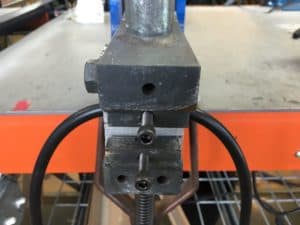 Vulcanized o-rings are a good choice for static sealing applications, or ones where the o-ring does not come in contact with moving parts. They are not recommended in dynamic applications, where the o-ring is subjected to the stress of moving parts. Vulcanized o-rings also may not be a good choice for those who need very large quantities of o-rings. In this case, it could be more cost-effective to create tooling and buy custom molded o-rings.
Vulcanized o-rings are a good choice for static sealing applications, or ones where the o-ring does not come in contact with moving parts. They are not recommended in dynamic applications, where the o-ring is subjected to the stress of moving parts. Vulcanized o-rings also may not be a good choice for those who need very large quantities of o-rings. In this case, it could be more cost-effective to create tooling and buy custom molded o-rings.
Different Options for Spliced & Vulcanized O-Rings
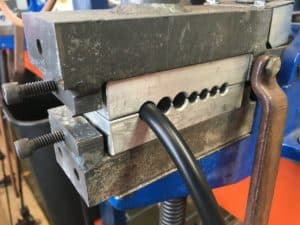 There are several key characteristics that define any vulcanized o-ring:
There are several key characteristics that define any vulcanized o-ring:
Material – type of rubber, color, durometerCross Section (CS) – thickness of the cord
Cut Length (CL) – calculated based on the desired diameter of the o-ring. See below.
Cut Angle: Butt Cut (default) is a 90 degree cut where the cord is cut straight from top to bottom. Bevel Cut (additional charge) is a 45 degree angle cut, also called a skive cut. This cut is used in order to have more of the material’s surface area in contact at the joint to make it stronger.
How to Calculate Cut Length
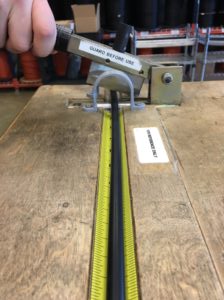 Since an o-ring is a circular shape, you must calculate the circumference, or the length of cord needed to form the o-ring with the desired diameter. Some commonly used terms for vulcanized o-rings include:
Since an o-ring is a circular shape, you must calculate the circumference, or the length of cord needed to form the o-ring with the desired diameter. Some commonly used terms for vulcanized o-rings include:
- CL = Cut Length
- ID = Inside Diameter
- OD = Outside Diameter
- MD = Mean Diameter
- π ≈ 3.1416 (rounded to 4 decimals to simplify calculations)
The formula for calculating the Cut Length (CL) for a vulcanized o-ring depends on your known dimensions:
ID and CS are known: CL = (ID + CS) * π
ID and OD are known: CL = ((ID + OD) / 2) * π
MD is known: CL = MD * π
Global O-Ring and Seal has an automatic Vulcanized O-Ring Calculator that calculates necessary dimensions of a vulcanized o-ring based on cross-section and any other known dimension such as ID, OD, MD, and cut length.
SHOP FOR VULCANIZED O-RINGSOur Commitment to Quality
Global O-Ring and Seal always inspects 100% of the vulcanized o-rings that we ship to our customers. This includes inspection of the joint to make sure there are no pinholes, breaks, or any flash (excess material). If any of these are present, we will either scrap or re-work the o-rings before shipping. This rigorous inspection process helps ensure consistent quality for all of our vulcanized o-rings.
Are you a distributor or user of sealing products who may have a need for spliced and vulcanized o-rings? Contact us to speak with one of our technical sales team members or request a quote online.

 English
English  Español
Español  Français
Français  Português
Português  Deutsch
Deutsch  Italiano
Italiano  Русский
Русский  中文
中文  日本語
日本語  العربية
العربية  हिन्दी
हिन्दी 

